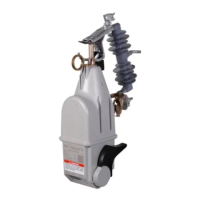62 S&C Instruction Sheet 461-504
Informational and Settings Screens
Reset Type. Select the reset method for the inverse curve segment from the drop-down
list: “D/T” (Denite Time) or “E/M” (Electromechanical). (This is not to be confused with
O/C Sequence Time setting. “Reset” here means how fast that curve will reset if it has
picked up but the fault disappears before the TripSaver II recloser could trip.) This eld
is mandatory.
Reset Time, s. Specify the time delay (in seconds) before the inverse curve segment resets
under D/T reset type (minimum value: 0; maximum value: 1,000). This eld is mandatory.
Reset Time, s (TM1, I0A). When the Reset Type setting is E/M, the title of the reset time
will be changed to “Reset Time, s (TM1, I0A).” The value specied here is the time delay
(in seconds) before the inverse curve segment resets when the Time Multiplier setting
is set at 1 and load current owing is at 0 A (minimum value: 0; maximum value: 1,000).
The actual reset time used by the Electromechanical Reset feature will be calculated
using the following quadratic algorithm: the value in this eld * the time multiplier entered/
(the load current/the minimum trip entered)^2 - 1). This eld is mandatory. See Figure 87.
Figure 87. The Reset Time setting field for E/M Reset Type.
Advanced TCC Curve Setup (optional). (Click on the Advanced TCC Curve Setup
button to expand/collapse area.) See Figure 88.
Figure 88. The Advanced TCC Curve Setup fields for a microprocessor recloser.

